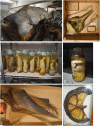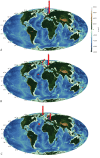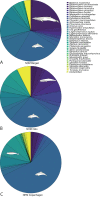Collecting whales: processes and biases in Nordic museum collections
- PMID: 38288462
- PMCID: PMC10823993
- DOI: 10.7717/peerj.16794
Collecting whales: processes and biases in Nordic museum collections
Abstract
Whales are unique museum objects that have entered collections in many ways and for different reasons. This work studies three Nordic natural history museum collections in Norway and Denmark with more than 2,500 whale specimens in total, and gathers the available biological and collection data on the specimens, which include skeletal elements, foetuses and organs preserved in ethanol or formalin, and a few dry-preserved organs. It finds that influx of specimens, which were mainly locally common species that were hunted, to the collections, mainly happened in the latest 1800s and earliest 1900s, fuelled by research trends, nation building, local whaling, and colonial mechanisms. Norway was a major whaling nation, but the largest hunt for whales in the Southern Ocean in the mid-1900s is not reflected in the Norwegian museum collections, probably because of the commercial focus of the whaling industry and logistical challenges, combined with limited research interest in zoological specimens at that time. The results demonstrate that it is important to understand these processes and the resulting biases for future research, outreach, and conservation.
Keywords: Bias; Collection process; Denmark; Museum collection; Norway; Whales; Whaling.
© 2024 Delsett.
Conflict of interest statement
The author declare that there is no competing interests.
Figures





Similar articles
-
Hydroids (Cnidaria, Hydrozoa) from Mauritanian Coral Mounds.Zootaxa. 2020 Nov 16;4878(3):zootaxa.4878.3.2. doi: 10.11646/zootaxa.4878.3.2. Zootaxa. 2020. PMID: 33311142
-
Molecular markers in keratins from Mysticeti whales for species identification of baleen in museum and archaeological collections.PLoS One. 2017 Aug 30;12(8):e0183053. doi: 10.1371/journal.pone.0183053. eCollection 2017. PLoS One. 2017. PMID: 28854252 Free PMC article.
-
Extensively remodeled, fractured cetacean tympanic bullae show that whales can survive traumatic injury to the ears.J Anat. 2016 Jan;228(1):125-36. doi: 10.1111/joa.12385. Epub 2015 Sep 22. J Anat. 2016. PMID: 26391309 Free PMC article.
-
Review of welfare concerns relating to commercial and special permit (scientific) whaling.Vet Rec. 2001 Mar 10;148(10):304-7. doi: 10.1136/vr.148.10.304. Vet Rec. 2001. PMID: 11315136 Review.
-
Calamities causing loss of museum collections: a historical and global perspective on museum disasters.Zootaxa. 2023 Jan 20;5230(2):153-178. doi: 10.11646/zootaxa.5230.2.2. Zootaxa. 2023. PMID: 37044851 Review.
References
-
- Alstrup AKO, Thøstesen CB, Madsen PT, Petersen HH, Jensen TK, Olsen MT, Kinze C. First stranding of Cuvier’s beaked whale (Ziphius cavirostris) on the Danish North Sea Coast. Aquatic Mammals. 2021;47(3):303–310. doi: 10.1578/AM.47.3.2021.303. - DOI
-
- Anderson WD, Pietsch TW. Collection building: an overview. In: Anderson WD, Pietsch TW, editors. Collection Building in Ichthyology and Herpetology. Lawrence, Kansas: The American Society of Ichthyologists and Herpetologists; 1997. pp. 3–12.
-
- Aniceto AS, Tassara L, Rikardsen A, Blévin P. Mass strandings of seven toothed and baleen whale species in Northern Norway in March 2020 call for further investigation. Polar Biology. 2021;44(7):1457–1461. doi: 10.1007/s00300-021-02869-6. - DOI
-
- Artsdatabanken Norwegian red list for species 2021. [In Norwegian] 2021. http://www.artsdatabanken.no/lister/rodlisteforarter/2021/ http://www.artsdatabanken.no/lister/rodlisteforarter/2021/
MeSH terms
Substances
LinkOut - more resources
Full Text Sources

